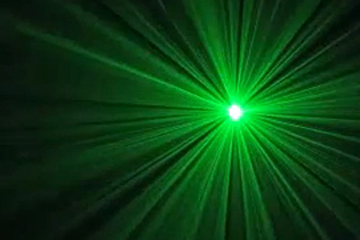Laser Pointer Might Provide Boost For Forensics

(ISNS) -- Green laser pointers are more than an easy-on-the-eye premium alternative to the more typical lecture aid, their red counterparts. A team of Israeli researchers has incorporated the green pointer into a portable system designed to detect tiny traces of hazardous materials cheaply and accurately.
Potential use of the technology, called Raman spectroscopy, which incorporates the pointer, extends to fieldwork on forensics.
"We tried it for detection of different liquids and solids which are related to explosives," said Ilana Bar, a physicist at Ben-Gurion University of the Negev in Israel. "In principle, other samples could also be tried."
"This system was found to allow high performance, offering the possibility of monitoring even single solid particles from residues of latent human fingerprints," Bar told the annual meeting of the American Physical Society's division of laser sciences in Rochester, New York, in October. "Since the overall system is modular, compact, and can be readily made portable, it can be easily applied to detection of different compounds and for forensic examination of objects."
The technology has another potential advantage in crime fighting. "It can be easily applied to the forensic examination of objects that are contaminated with drugs," Bar said.
"This paper advances the decades-long trend toward low-cost portable Raman spectrometers as universal tools for fingerprinting unknown substances,” said Daniel Schwartz, a University of Washington chemical engineer whose research focuses on Raman spectroscopy.
Bar and her team used their green laser pointer as the light source for Raman spectroscopy, which is already a well-established technology used to fingerprint molecules.
Sign up for the Live Science daily newsletter now
Get the world’s most fascinating discoveries delivered straight to your inbox.
A Raman spectrometer shines highly monochromatic light -- that is, light of a single color -- at a sample of the material under investigation. Vibrations and rotations of molecules in the material react to the light and increase or decrease its frequency by small amounts. The extent of the frequency changes in light emitted from the sample serves to identify the molecules that cause them.
Because the Raman signals are very faint in comparison with the light that stimulates them, it is difficult to separate out those signals from other wavelengths of light. To compensate for that problem, most Raman spectrometers use lasers as their light sources. Typical instruments use large lasers set up in a specialized laboratory.
That process has very high sensitivity. A team at the Naval Research Laboratory has applied Raman spectroscopy to differentiate substances in nanoparticles.
Portable Raman spectrometers are also available, for use by the military and the police, for example. Their drawback is their cost: typically between $10,000 and $30,000 per instrument.
Here's where the green laser pointer comes in.
"Since this laser is one that can be purchased for personal use, we wanted to try it due to its low cost," Bar said, adding that the green laser's shorter wavelength would improve the "inherently weak Raman signal."
"The spectral sharpness of the green laser pointer ought to be fairly good," added Andrew Berger of the University of Rochester’s Institute of Optics. "It seems plausible that it could be a cheaper source of narrow-band light."
The use of the green pointer also gives the instrument the advantage of small size.
"The size of the spectrometer is about 24 inches by 12 inches," Bar said. "In principle, its size could be decreased if we used a smaller detector."
According to Bar, the device has two advantages over portable Raman spectrometers in current use.
"According to data available in the literature, the sensitivity of our system is higher; the signal observed is larger and the time it takes to obtain the signal is shorter," Bar said. "It can also provide an image of particles in a sample. That's a task that is usually fulfilled only by the use of cumbersome large Raman microscopes."
When compared with other forensic technologies, the new system has one drawback, indirectly caused by the laser pointer.
"It can be used only for point detection," Bar said. "The beam can be scanned to find the position of material in other particles, but it cannot detect anything outside the beam."
However, the spectrometer’s ability to identify the composition of single particles means that it can provide an effective adjunct to traditional forensic methods.
A former science editor of Newsweek, Peter Gwynne is a freelance science writer based on Cape Cod, Mass.
Inside Science News Service is supported by the American Institute of Physics.









